| DESCRIPTION | HISTORY |
Please Click On Any Picture for a Larger Version
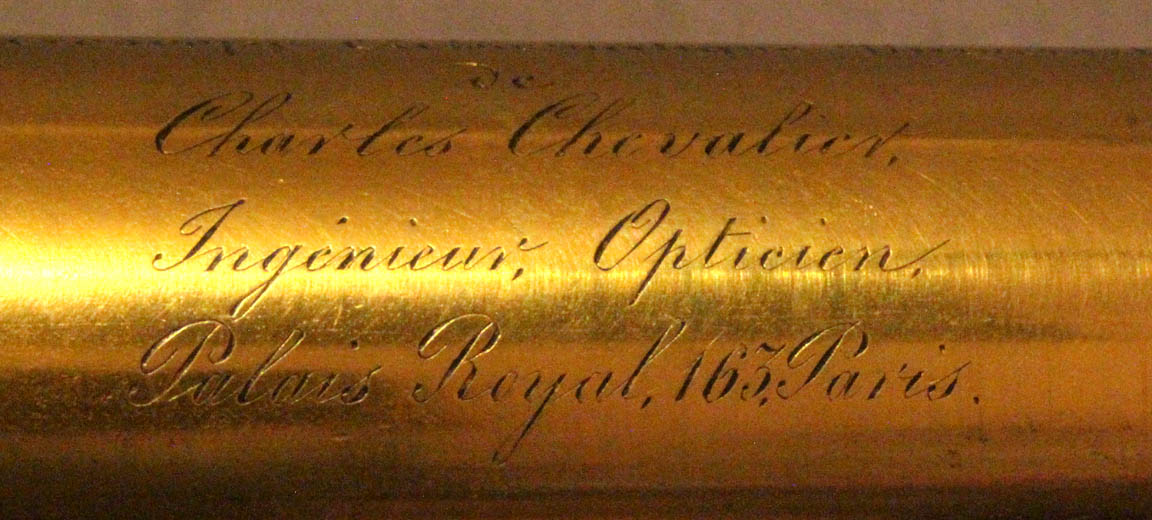 This microscope can be arranged in a variety of configurations. When in the horizontal mode it is about 9 3/4 inches tall. When in the upright vertical mode, it is about 14 inches tall. The base, a realistic modern solid brass replacement, is 5 inches in diameter. The mirror housing is about 2 1/2 inches in outside diameter, with the smaller flat mirror portion about 1 3/4 inches in diameter. It is signed in script on the optical tube. It arises from a round pillar which screws in to the base. At the top of the pillar is a compass joint. The bottom of the limb, or stem as Chevalier called it, is locked against the pillar with a removeable pin. This pin must be removed for inclination. The rectangular mirror support slides up and down the lower limb or stem, and supports a short arm that swivels left or right. The mirror housing at the end of short arm is in a gimbal. The mirror itself, has a larger concave side and a smaller flat side; this configuration, that is, that the flat mirror is smaller, is a Chevalier hallmark, seldom seen on microscopes by other makers. The microscope stage is moved up and down for focusing by rack and pinion, the rack being inlaid into the limb. The stage support has a receptacle with a diamond shaped profile which could accept more than one type of stage, and because it is diamond shape, rather than a dovetail, it allows the stages to be inserted correctly in both the vertical and inverted configurations. The only stage with the instrument at this time has a cutout opening, and it may not be original. There is a provision to tighten the diamond shaped opening via a slotted screw. The stage support also holds the substage aperture wheel. This wheel can be turned 90 degrees to a vertical position but also can be swung out of the way.
This microscope can be arranged in a variety of configurations. When in the horizontal mode it is about 9 3/4 inches tall. When in the upright vertical mode, it is about 14 inches tall. The base, a realistic modern solid brass replacement, is 5 inches in diameter. The mirror housing is about 2 1/2 inches in outside diameter, with the smaller flat mirror portion about 1 3/4 inches in diameter. It is signed in script on the optical tube. It arises from a round pillar which screws in to the base. At the top of the pillar is a compass joint. The bottom of the limb, or stem as Chevalier called it, is locked against the pillar with a removeable pin. This pin must be removed for inclination. The rectangular mirror support slides up and down the lower limb or stem, and supports a short arm that swivels left or right. The mirror housing at the end of short arm is in a gimbal. The mirror itself, has a larger concave side and a smaller flat side; this configuration, that is, that the flat mirror is smaller, is a Chevalier hallmark, seldom seen on microscopes by other makers. The microscope stage is moved up and down for focusing by rack and pinion, the rack being inlaid into the limb. The stage support has a receptacle with a diamond shaped profile which could accept more than one type of stage, and because it is diamond shape, rather than a dovetail, it allows the stages to be inserted correctly in both the vertical and inverted configurations. The only stage with the instrument at this time has a cutout opening, and it may not be original. There is a provision to tighten the diamond shaped opening via a slotted screw. The stage support also holds the substage aperture wheel. This wheel can be turned 90 degrees to a vertical position but also can be swung out of the way.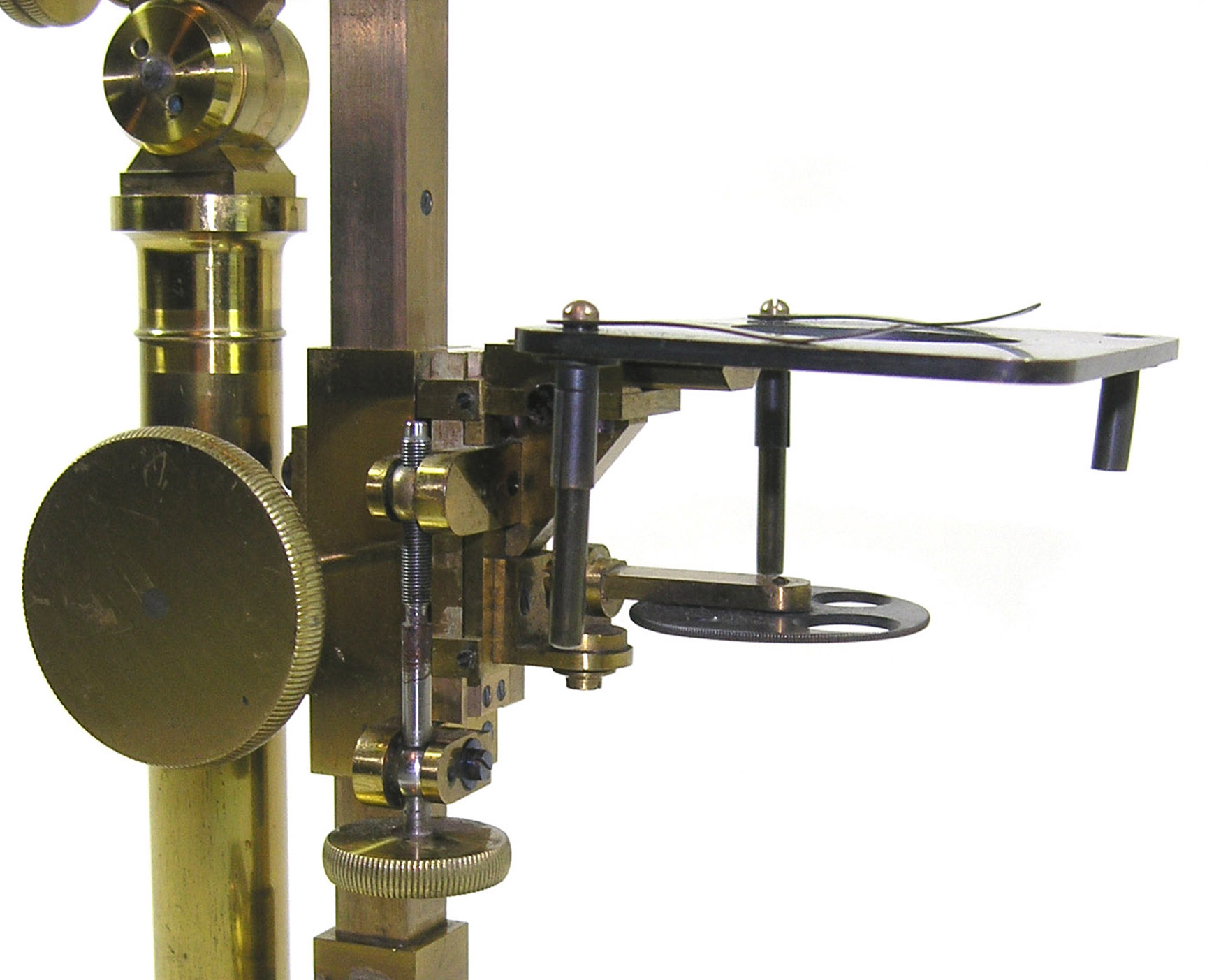 Although this microscope does not have a Helvesius (or Helvetius) screw fine focus in addition to the rack and pinion coarse focusing, an example of one with this feature from another collection, is shown to the right.
Although this microscope does not have a Helvesius (or Helvetius) screw fine focus in addition to the rack and pinion coarse focusing, an example of one with this feature from another collection, is shown to the right.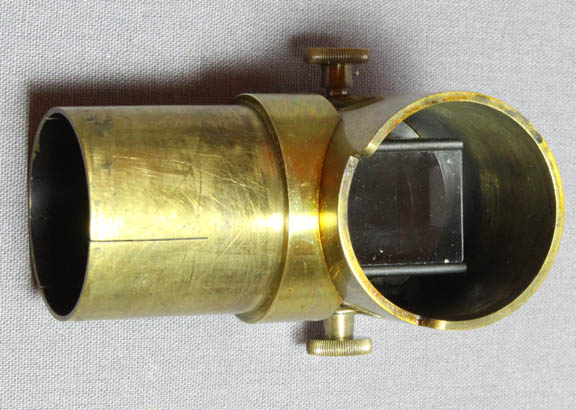
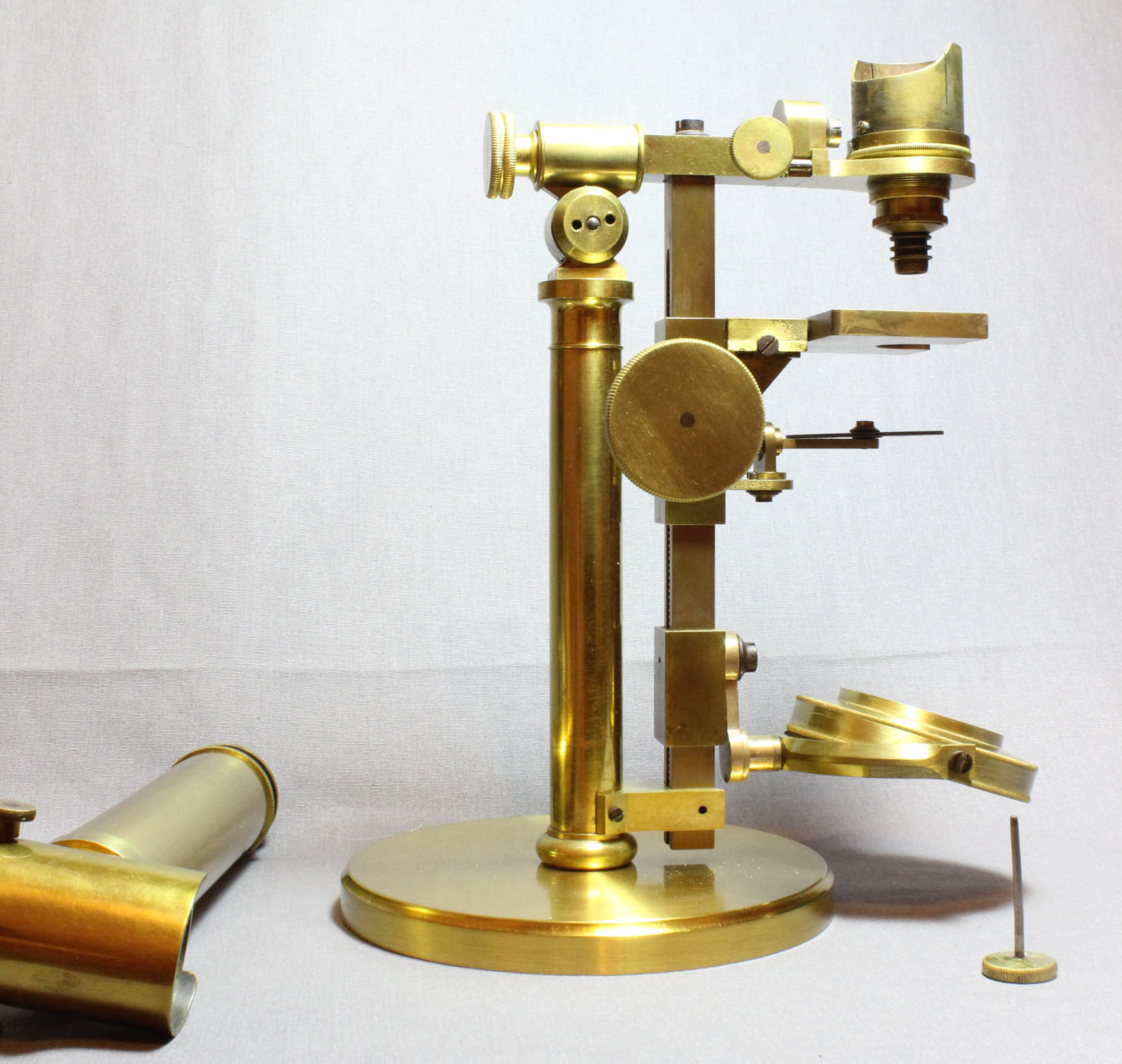 The prism assembly (V-A in the engraving) may be removed to allow the main optical tube to fit onto the support for direct vision through the objective.
The prism assembly (V-A in the engraving) may be removed to allow the main optical tube to fit onto the support for direct vision through the objective. 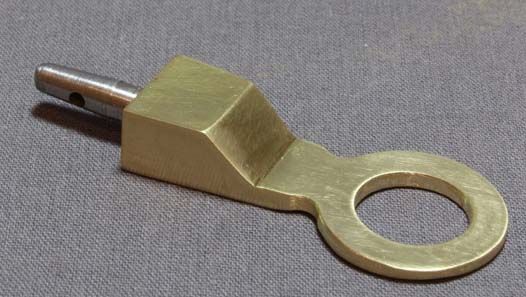
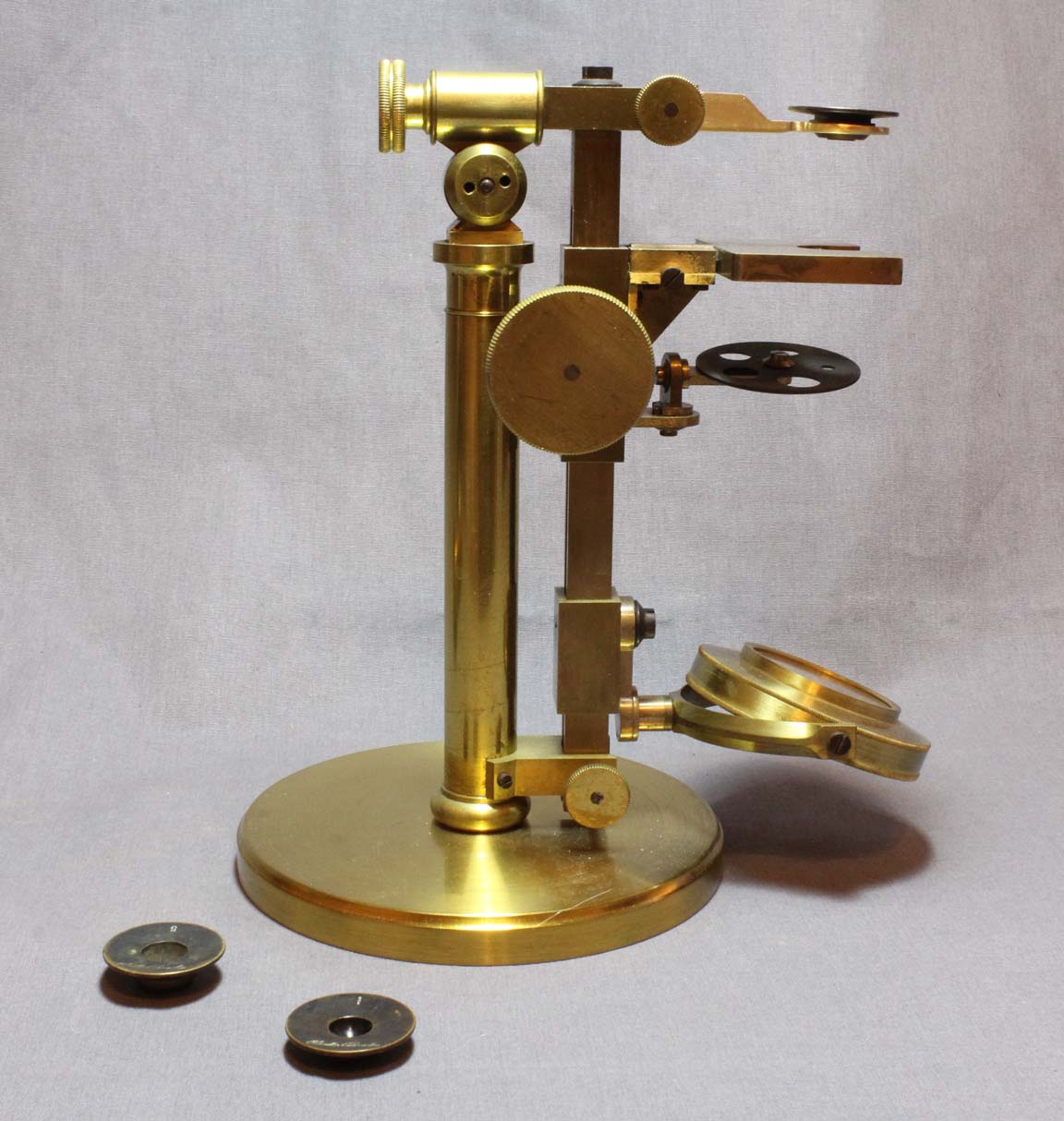 There is a provision to substitute a simple microscope for the compound, and although the original single (simple)microscope arm is not with this instrument, I did fabricate a reasonably accurate replica which is shown here to the left. I based this on two other instruments which did have the part, which was missing from mine. My instrument shown set up for use with the simple doublets, is shown to the right. Because they were individually made, there were slight differences from one microscope to the next. In this case the distance from the limb to the optical path is slightly shorter than one of the other examples, and therefore the support for the doublets on mine had to be shorter than the other example I used as a model for mine. This deceivingly simple part was not easy to make, taking many hours to produce.
There is a provision to substitute a simple microscope for the compound, and although the original single (simple)microscope arm is not with this instrument, I did fabricate a reasonably accurate replica which is shown here to the left. I based this on two other instruments which did have the part, which was missing from mine. My instrument shown set up for use with the simple doublets, is shown to the right. Because they were individually made, there were slight differences from one microscope to the next. In this case the distance from the limb to the optical path is slightly shorter than one of the other examples, and therefore the support for the doublets on mine had to be shorter than the other example I used as a model for mine. This deceivingly simple part was not easy to make, taking many hours to produce. 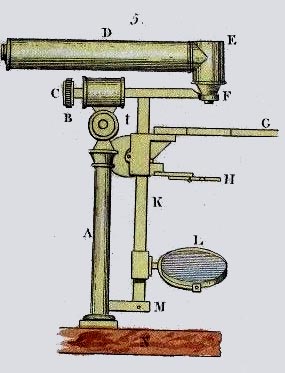 Charles Chevalier(1804-1859) was a famous optician in Paris, and was one of the first to use multiple lenses screwed together into one group to achieve higher power objectives. He initially worked in partnership with his father Vincent, with the help of M. Selligue, and later on his own. Selligue experimented heavily with lens combinations and was partially successful. Selligue and Charles Chevalier apparently first made microscopes of the horizontal design patterned after those of the famous Italian Giovanni Amici. Amici used reflecting optics in an attempt to solve the problem of chromatic aberration, but Chevalier continued to make microscopes in the horizontal configuration without reflecting optics. He used a prism to bend the light path 90 degrees.
Charles Chevalier(1804-1859) was a famous optician in Paris, and was one of the first to use multiple lenses screwed together into one group to achieve higher power objectives. He initially worked in partnership with his father Vincent, with the help of M. Selligue, and later on his own. Selligue experimented heavily with lens combinations and was partially successful. Selligue and Charles Chevalier apparently first made microscopes of the horizontal design patterned after those of the famous Italian Giovanni Amici. Amici used reflecting optics in an attempt to solve the problem of chromatic aberration, but Chevalier continued to make microscopes in the horizontal configuration without reflecting optics. He used a prism to bend the light path 90 degrees.